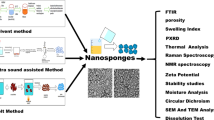Abstract
Microspheres of tramadol hydrochloride (TM) for oral delivery were prepared by complex coacervation method without the use of chemical cross-linking agents such as glutaraldehyde to avoid the toxic reactions and other undesirable effects of the chemical cross-linking agents. Alternatively, ionotropic gelation was employed by using sodium-tripolyphosphate as cross-linking agent. Chitosan and gelatin B were used as polymer and copolymer, respectively. All the prepared microspheres were subjected to various physicochemical studies, such as drug–polymer compatibility by thin layer chromatography (TLC) and Fourier transform infrared (FTIR) spectroscopy, surface morphology by scanning electron microscopy, frequency distribution, drug entrapment efficiency, in vitro drug release characteristics and release kinetics. The physical state of drug in the microspheres was determined by differential scanning calorimetry (DSC) and X-ray diffractometry (XRD). TLC and FTIR studies indicated no drug–polymer incompatibility. All the microspheres showed initial burst release followed by a fickian diffusion mechanism. DSC and XRD analysis indicated that the TM trapped in the microspheres existed in an amorphous or disordered-crystalline status in the polymer matrix. From the preliminary trials, it was observed that it may be possible to formulate TM microspheres by using biodegradable natural polymers such as chitosan and gelatin B to overcome the drawbacks of TM and to increase the patient compliance.







Similar content being viewed by others
REFERENCES
Allegaert K, Anderson BJ, Verbesselt R, Debeer A, de Hoon J, Devlieger H, et al. Tramadol disposition in the very young: an attempt to assess in vivo cytochrome P-450 2D6 activity. Br J Anaesth. 2005;95:231–9.
Varshosaz J, Tavakoli N, Kheirolahi F. Use of hydrophilic natural gums in formulation of sustained-release matrix tablets of tramadol hydrochloride. AAPS PharmSciTech. 2006;7:E1–7.
Malonne H, Coffiner M, Fontaine D, et al. Long-term tolerability of tramadol LP, a new once-daily formulation, in patients with osteoarthritis or low back pain. J Clin Pharm Ther. 2005;30:113–20.
Kumar P, Singh S, Mishra B. Development and biopharmaceutical evaluation of extended release formulation of tramadol hydrochloride based on osmotic technology. Acta Pharm. 2009;59:15–30.
Mattia C, Coluzzi F. Once-daily tramadol in rheumatological pain. Expert Opin Pharmacother. 2006;7:1811–5.
Finkel JC, Rose JB, Schmitz ML, Birmingham PK, Ulma GA, Gunter JB, et al. An evaluation of the efficacy and tolerability of oral tramadol hydrochloride tablets for the treatment of post surgical pain in children. Anesth Analg. 2002;94:1469–73.
Cai D-Z, Zeng C, Quan D-P, Bu L-S, Wang K, Lu H-D, et al. Biodegradable chitosan scaffolds containing microspheres as carriers for controlled transforming growth factor-β1 delivery for cartilage tissue engineering. Chin Med J. 2007;120:197–203.
Yassin AEB, Alsarra IA, Al-Mohizea AM. Chitosan beads as a new gastroretentive system of verapamil. Sci Pharm. 2006;74:175–88.
Denkbas EB. Perspectives on: chitosan drug delivery systems based on their geometries. J Bioact Compat Polym. 2006;21:351–68.
Gilberto C, Moreno B, Andrea C, Tiziana R, Santo S, Valentina I. Toxicity and gut associated lymphoid tissue translocation of polymyxin B orally administered by alginate/chitosan microparticles in rats. J Pharm Pharmacol. 2008;60:21–6.
Shankar C, Mishra B. Development and in-vitro evaluation of gelatin A microspheres of Ketorolac tromethamine for intranasal administration. Acta Pharm. 2003;53:101–10.
Shu XZ, Zhu KJ. Chitosan/gelatin microspheres prepared by modified emulsification and ionotropic gelation. J Microencaspul. 2001;18:237–45.
Carmen RL, Roland B. Effect of formulation and process variables on the formation of Chitosan-gelatin coacervates. Int J Pharm. 1996;135:63–72.
Koa JA, Park HJ, Hwang SJ, Park JB, Lee JS. Preparation and characterization of chitosan microparticles intended for controlled drug delivery. Int J Pharm. 2002;249:165–74.
Shu XZ, Zhu KJ. A novel approach to prepare tripolyphasphate/chitosan complex beads for controlled release drug delivery. Int J Pharm. 2000;20:51–8.
Dubey RR, Parikh RH. Two-stage optimization process for formulation of Chitosan microspheres. AAPS PharmSciTech. 2003;5:1–9.
Gandhimathi M, Ravi TK, Shukla N. Simultaneous determination of Aspirin and Clopidogrel in tablets by HPTLC method. Indian Drugs. 2006;43:397–9.
Shu XZ, Zhu KJ, Song W. Novel pH-sensitive citrate cross-linked chitosan film for drug controlled release. Int J Pharm. 2001;212:19–28.
Manna AK, Ray S, Gupta BK, Ghosh LK. Product development studies on control release delivery system of Nitrofurantoin. J Pharm Res. 2005;4:16–8.
Dash AK. Determination of the physical state of drug in microcapsule and microsphere formulations. J Microencapsul. 1997;14:101–12.
Aiedeh K, Ganasi E, Orient I, Zeeshi V. Chitosan microcapsules as controlled release systems for insulin. J Microencapsul. 1997;14:567–76.
Jeyanthi R, Mehta C, Thanoo BC, Deluca PP. Effect of processing parameters on the properties of peptide-containing polylactic-co-glycolic acid (PLGA) microspheres. J Microencapsul. 1997;14:163–74.
Denkbas ED, Seyyal M, Piskins E. 5-Fluorouracil loaded Chitosan microspheres for chemo embolization. J Microencapsul. 1999;6:741–9.
Korsmeyer RW, Gurny R, Doelker E, Buri P, Peppas NA. Mechanisms of solute release from porous hydrophilic polymers. Int J Pharm. 1983;15:25–35.
Costa P. An alternative method to the evaluation of similarity factor in dissolution testing. Int J Pharm. 2001;220:77–83.
Zidan AS, Sammour OA, Hammad MA, Megrab NA, Hussain MD, Khan MA, et al. Formulation of Anastrozole microparticles as biodegradable anti cancer drug carriers. AAPS PharmSciTech. 2006;7:E1–9.
Corrigan OI. Thermal analysis of spray dried products. Thermochim Acta. 1995;248:245–58.
ACKNOWLEDGEMENTS
The authors are thankful to Sun Pharmaceutical Industries Ltd., Maharashtra, India for gift sample of TM, Central Institute of Fisheries and Technology, Cochin, India for providing gift sample of chitosan, respectively. The authors greatly acknowledge Indian Institute of Science, Bangalore, India for the technical assistance in analytical studies.
Author information
Authors and Affiliations
Corresponding author
Electronic supplementary material
Below is the link to the electronic supplementary material.
ESM 1
(XLS 25 kb)
Rights and permissions
About this article
Cite this article
Basu, S.K., Kavitha, K. & Rupeshkumar, M. Evaluation of Ionotropic Cross-Linked Chitosan/Gelatin B Microspheres of Tramadol Hydrochloride. AAPS PharmSciTech 12, 28–34 (2011). https://doi.org/10.1208/s12249-010-9537-2
Received:
Accepted:
Published:
Issue Date:
DOI: https://doi.org/10.1208/s12249-010-9537-2




